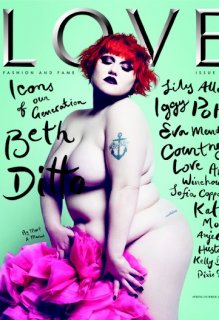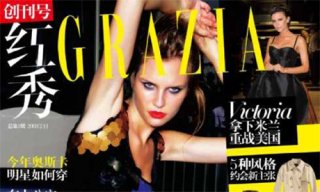Stylist and editor Katie Grand: a style maverick
A perfectly honed instinct for cool – and friendship with fashion’s edgiest stars – have turned Katie Grand into a celebrity in her own right. Now the style maverick turned queen bee launches a new magazine, Love.
It is a crisp December day in London. On Bond Street, London, the lights and window displays twinkle as they do every Christmas, even as the financial news grows ever more dire. Around the corner in Flash, a pop-up restaurant, a similarly glittering crowd have gathered to celebrate the birth of a high-end, biannual style magazine called Love, including designers Giles Deacon, Alexander McQueen and Gareth Pugh, models Agyness Deyn and Jade Parfitt and singer Beth Ditto.
It might not seem like the ideal time to bring an upscale new magazine into the world, but the odd couple whose love child Love is seem content enough. Mr Glossy himself, Nicholas Coleridge, boss of the Condé Nast publishing group, is oozing charm, a proconsular figure in pinstripes. And alongside him, Katie Grand – global tastemaker, super-stylist and now editor-in-chief of Love, Condé Nast’s latest title – is wearing killer heels and a look of complete contentment as she greets old friends and larks around with Deyn and Ditto, Love’s first cover star.
Ditto might not be everyone’s idea of a pin-up, but neither is Katie Grand most people’s idea of a fashion maven. Even today, looking glam, she’s more Hoxton-cool than Devil Wears Prada. Her hair can be frizzy, she has a gap between her front teeth (which is actually rather winning, but most people in fashion would have had it “fixed” at the earliest opportunity), and she speaks with a slight Brummie accent. And while Cockney easily trumps the plummy tones of Condé Nast’s Voguettes in the cool stakes, Brummie just isn’t the accepted sound of fashion.
Grand, in her late thirties, is no household name, but she is arguably one of the most influential people in fashion today. She is the stylist who has finessed the collections of Miuccia Prada and Marc Jacobs for the runway. She’s also the alchemist who, at Dazed & Confused, Another Magazine and Pop, combined a quirky take on fashion with an eye for photography and the willing participation of best mates such as Kate Moss to produce some truly extraordinary style magazines.
Love, aka What Katie Did Next, looks set to be Grand’s crowning triumph, with a launch issue stacked with lucrative advertising even as much of the industry struggles in the face of the crunch. As one of her oldest friends, the photographer Liz Collins, explains, when Grand, Deacon and the gang gathered for the after-party drinks at J. Sheekey, “There was this feeling that somehow we’ve all made it.”
Collins took several of the portraits of Grand which accompany this feature, the first when both were schoolgirls in Birmingham. “Lizzie’s mum hated me,” Grand recalls, “because she knew my dad [an academic] was liberal, so she knew Liz was up to no good at my place.” The latest shot, on our cover, was taken last month alongside model Jourdan Dunn, also currently at the top of her game – but who, when Grand first met her a few years ago in New York, “was just starting out, this gorgeous little thing, and we made her walk in these heels and she couldn’t, she did that Bambi thing. But now watch her walk!”
You could say the same about Grand, often seen striding around in the highest of heels. “I love shoes,” she says, admitting to an Imelda-beating “1,500 pairs – I’ve got a room full,” in the home in Tufnell Park she shares with Steve Mackey, the Pulp drummer. Famously, Grand also keeps all the clothes she has ever owned, a kind of archive of personal style, if you like, stored in alphabetical order: A for Alaïa, B for Balenciaga, and so on. And an archive of magazines, including the copies of Vogue and The Face she was reading as a teenager.
At that point, Grand’s drive was already obvious; where it would take her, less so. “I’m hopeless at art,” she admits. “But that was the field I wanted to get into. So I went to pottery classes and sculpture classes and made myself good at those things.” Then she started reading glossies and style mags, “wanting to be cool”. Needless to say, she planned to become editor of Vogue – and gamely wrote to its incumbent, Liz Tilberis, for advice. Tilberis told Grand to go to college, which she did, but given the scale and urgency of Grand’s ambitions, it’s no surprise that Central St Martins College of Art and Design proved to be a disappointment.
While studying there, though, she did meet the photographer Rankin, which would prove to be far more crucial than any degree. He had already enjoyed some professional success, but, to his irritation, had been rebuffed by The Face. And so in 1991, along with Grand and journalist Jefferson Hack, Rankin launched Dazed & Confused, a style mag that would define the era as effectively as i-D and The Face had defined theirs.
“Jefferson said to me the other day, ‘We were the biggest load of f***ing blaggers!’” says Grand. “We were complete idiots, but completely fearless – so bloody arrogant, but naive about how the industry works. Because I’d never worked for anyone, no one ever said this is how you get money.” Some readers would simply be utterly confused by Dazed. But The Face was impressed, co-opting Grand as fashion director – and winning her over with the prospect of her own magazine, Pop.
Launched in 2000, Pop was the last word in edgy. Grand’s final issue of the magazine, still on newsstands today, includes fashion shoots using a monkey and a sow as models. But the magazine proved a magnet for fashion advertisers, many of whom were also turning to Grand for input about their own collections, as Grand’s freelance career morphed from styling new bands (“Someone always tried to nick something!”) to the kind of consulting work she does today, for which she might earn as much as £3,000 or £4,000 a day.
Pop, as the name suggests, showed a keen understanding of how to tap into popular culture, with cover stars such as J-Lo, Kylie and Kate Moss. Once the chosen cover star had been shot by one of Pop’s stable of photographers (Mert & Marcus, perhaps, or Alice Hawkins), then Grand would turn to her friend, ex-Heat editor Mark Frith, to tweak the “cover lines” for maximum impact on Britain’s super-competitive newsstands.
Not that a style magazine like Pop was seeking to emulate Heat’s circulation – then around the 500,000 mark. Instead, what Grand has always tried to do is attract a small but powerful global constituency of fashion insiders. So successful was she that Nicholas Coleridge came calling. He tried to buy Pop from its publisher, Bauer. The company played hard to get, but lost out in one of last year’s most spectacular media coups, when Grand and her whole team defected en masse to Condé Nast. That’s an eloquent expression of loyalty, even if Grand concedes that she can be a “demanding” or “difficult” boss. (“The new era for Pop”, meanwhile, begins autumn 2009, says Bauer.)
As for Coleridge, Grand describes him as “probably the most charming man I’ve ever met”. For his part, Coleridge says he “got to know Katie from seeing her at the shows, liked her,” and recalls that, “Whenever I looked at Pop, I thought it seemed like we should be publishing it.” Powers of diplomacy have been deployed all round in welcoming this latest recruit into the Condé Nast fold. Grand isn’t moving into Vogue House, working instead out of Love’s new offices in Clerkenwell, and one senses that Coleridge and Grand both recognised that a semi-detached relationship would be key to making the marriage between Condé Nast (established, corporate and posh) and Grand (self-taught, maverick and edgy) work well. Perhaps this little bit of distance also suits the Vogue editors on both sides of the Atlantic.
Grand now enjoys the kind of marketing expertise and infrastructure she could only have dreamt about at Dazed. And access to photographers such as David Sims, whom she would effectively have been “blocked” from using, as Coleridge puts it, while outside the Condé Nast fold. (Rumours abound that US Vogue’s Anna Wintour has sought to ring-fence some of her own key contributors; but neither Grand – “I’m just keeping my head down!” she jokes – nor Coleridge will admit there’s any substance to them.)
So what does Love look like – and why do we need another style mag in times like these? Grand’s editor’s letter refers to the “reality check” we’re all going through, not least the fashion industry, and clearly that has had an impact on the aesthetic of Love, even if all the ads have been sold. “This time last year I said I really wanted to do an issue with no retouching. I don’t want to see a redrawn image of a woman – I’m just not interested. It feels too glossy, too shallow…”
So while Pop was famously “super-glossy”, Love will be different – witness the cover star, Beth Ditto. There are moving portraits of Anjelica Huston taken by Terry Richardson, whose father, photographer Bob Richardson, had an affair with Huston in the early Seventies, and profiles of Iggy Pop and designer Pam Hogg.
There’s also a photo shoot of Kate Moss by Mert & Marcus, hitherto famous for their retouched, high-octane fashion photography. “Only this,” explains Grand, “was shot at a Madonna concert in Paris, when we all went dressed as Madonna, with no hair and make-up, no retouching, just really raw.” Grand by name then, but not by nature, and while she might now have a Condé Nast budget, for Katie, running a magazine is still about doing cool things with your mates.








